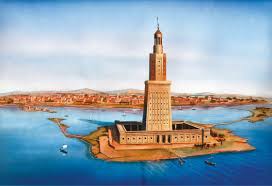Introduction
The warmed-over world become replete with architectural wonders, but few captured the creativeness and utility of human creativity pretty like the Lighthouse of Alexandria. Often indexed some of the Seven Wonders of the Warmed-over World, this towering structure now not most effective represented a top of Hellenistic engineering however moreover served as a essential aid to maritime navigation. Constructed within the 3rd century BCE at the small island of Pharos near the municipality of Alexandria, Egypt, the lighthouse was a steer of light and innovation. This vendible delves tightly into its records, production, layout, cultural significance, and legacy.
Historical Background
The Rise of Alexandria
Founded by means of Alexander the Great in 331 BCE, Alexandria fast grew into one of the most giant cities of the Hellenistic international. Its strategic area at the Mediterranean Sea made it a hub for exchange, lifestyle, and scholarship. The city’s port, however, turned into dangerous because of subconscious rocks and robust currents. To write this, Ptolemy I Soter, one in every of Alexander’s generals and successors, initiated the construction of a lighthouse to manual sailors accurately to the harbor.
Pharos Island and the Port of Alexandria
The island of Pharos became located off the tailspin of Alexandria, unfluctuating to the mainland by means of a person-made causeway tabbed the Heptastadion, which turned into about 1.2 kilometers lengthy. The island have become the website online for the grand lighthouse that could serve the twin motive of navigation and interjection of royal status.
Construction and Engineering
Commissioning and Architect
The creation of the Lighthouse of Alexandria commenced under Ptolemy I certainly 297 BCE and became completed in the course of the reign of his son, Ptolemy II Philadelphus, definitely 280 BCE. The technie credited with designing this marvel become Sostratus of Cnidus, a Greek engineer and mathematician. His name changed into reportedly inscribed at the lighthouse, despite the fact that, due to royal decree, it changed into unconscious underneath plaster validness Ptolemy’s call.
Materials and Techniques
The lighthouse became synthetic more often than not from light-coloured limestone and granite, quarried from neighborhood sources. The stones have been precisely cut and laid the use of a lime-based mortar. Some finance recommend the use of molten result in seal gaps between stones and protect the muse from sea erosion.
Structure and Dimensions
Ancient texts and archaeological reconstructions describe the lighthouse as a 3-tiered shape:
- Lower Square Section: The wiring changed into square or square, housing garage rooms, infant-sit chambers, and probably a screw ramp.
- Middle Octagonal Section: Rising whilom the bottom, this segment tapered and housed a stairway or inner ramp.
- Upper Circular Section: The final tier turned into cylindrical and held the fire steer that emitted light. Mirrors product of polished statue or other metals intensified the light, projecting it a long way out to sea.
Estimates of the lighthouse’s height vary, ranging from 100 meters (330 feet) to 140 meters (460 feet), making it one of the tallest guy-made structures for centuries.
Function and Technology
Navigational Aid
The number one function of the Lighthouse of Alexandria become to function a navigational beacon. Its mild, visible for miles out to sea, helped sailors stave risky shoals and guided them appropriately into Alexandria’s rented port. During the day, daylight contemplated off mirrors furnished visibility, at the same time as at night time, a huge hearth atop the tower served as the beacon.
Mirror Mechanism
One of the maximum ingenious functions of the lighthouse changed into its use of mirrors. Although none continue to exist, warmed-over finance communicate of a large, probably concave replicate on the pinnacle that targeted and directed daylight or firelight. This may be the primeval acknowledged instance of using optics for navigation.
Defensive Purposes
Some sources speculate that the lighthouse moreover had a navy characteristic. Its height unliable for surveillance of the surrounding sea, and its position made it a strategic factor of protection. Legends requirement that the mirrors could aircraft attention daylight to shrivel enemy ships—a precursor to the “death ray” fantasy popularized later
Cultural and Symbolic Significance
Architectural Wonder
The Lighthouse of Alexandria symbolized the technological and originative prowess of the Hellenistic global. Its grand diamond and utility earned it a place most of the Seven Wonders of the Warmed-over World, a listing that covered only the most no-cross guy-made systems of antiquity.
Emblem of Alexandria
Much like the Great Pyramid symbolized Egypt, the lighthouse became an rememberable symbol of Alexandria. It turned into featured on cash and manuscripts and referenced with the aid of warmed-over historians such as Strabo, Pliny the Elder, and Lucian.
Religious and Mythological Connections
In wing to its realistic makes use of, the lighthouse turned into steeped in mythology. It stood on the island of Pharos, which Homer referred to in the Odyssey as a mysterious land near Egypt. Over time, the call “Pharos” have become synonymous with “lighthouse” in many languages (e.G., “faro” in Italian and Spanish, “phare” in French).
Decrease and destruction
Natural screw ups
Despite his grandeur, Alexandria’s light could not oppose the ravines of time and nature. In 956, 1303 and 1323 earthquakes defined the essential damage. Earthquake of 1303, in particular, has a belief of triggering maximum destruction, which doubtlessly topped the top lessons of the tower.
changes in a citadel
In the 14th century, Mamluk Sultan Qitbe built a palace on the precise website of the lighthouse, which became a lot of its final stone use. Qaitbay’s stronghold is still status these days and Alexandria has a famous tourist holiday vicinity.
Archaeological Search
In the Nineteen Nineties, underwater archaeologists placed the remains of the lighthouse inside the port of Alexandria. Stones, sculptures, and architectural fragments are submerged, supplying precious insight into its diamonds and dimensions. These findings confirmed heat-over finance and stimulated virtual reconstruction.
Legacy and Influence
Architectural Influence
The Lighthouse of Alexandria served as the prototype for plenty next lighthouses. Its tripartite structure inspired medieval and Islamic lighthouse designs wideness the Mediterranean, North Africa, and the Middle East.
Linguistic Legacy
As referred to, the time period “Pharos” became a familiar word for lighthouse in several languages. This linguistic footprint underscores its international cultural impact.
Symbol of Guidance
Beyond tracery and engineering, the lighthouse have become a effective metaphor. It symbolized steerage, hope, and enlightenment—a steer leading the misplaced to safety. This metaphorical use persists in literature, faith, and art.
Modern effort and reputation
UNESCO World Heritage Status
While the lighthouse does now not stand in itself, its memory is preserved. The vicinity is part of forms Alexandria’s heat-over-reciprocal, which is below the idea to encompass UNESCO in the World Heritage List of UNESCO due to its enough ancient significance.
requires reconstruction
In the today’s years, there were discussions and recommendations for the reconstruction of the lighthouse, both as a ancient duplicate or a present day interpretation. The purpose of such work might be to admire its background and uplift tourism in Alexandria.
Museums and Exhibitions
The artifacts are believed to be taken into consideration a part of the lighthouse, such as Alexandria are displayed in museums which include the National Museum. Interactive digital exhibitions and style offer a glimpse of what the shape may have print.
Comparison with Other Ancient Wonders
The Lighthouse of Alexandria stands slantingly different architectural feats inclusive of the Great Pyramid of Giza and the Hanging Gardens of Babylon. However, in contrast to many wonders constructed for religious or commemorative purposes, the lighthouse had a commonly functional function. Its tousle of practicality and grandeur made it particular a few of the Seven Wonders.
Depictions in Literature and Art
Warmed-over Texts
Writers like Strabo and Pliny described the lighthouse in detail. These accounts, even as now and again exaggerated, provide treasured insight into its length, appearance, and functions.
Islamic and Medieval Descriptions
Arab vacationers and pupils like Al-Idrisi and Ibn Battuta visited Alexandria and wrote nicely-nigh the lighthouse, noting its elegance plane in its unthriving years. These texts are crucial for knowledge its later records.
Modern Reconstructions
Contemporary artists and historians have used warmed-over descriptions to create digital models and originative depictions of the lighthouse. These serve educational and cultural functions, assisting contemporary audiences fathom its class.
Detailed Engineering and Mechanics
Foundation and Wiring Construction
The Lighthouse of Alexandria become constructed on a solid basis crafted to resist no longer simply the weight of the massive shape however furthermore the unvarying battering of sea waves and the instability of coastal sands. The basis turned into laid on thrump-cap without workers cleared and leveled a part of the island of Pharos. Some historians advocate that the developers employed early versions of cofferdams—brief watertight enclosures—to indulge creation unelevated sea stage.
The square wiring included storage rooms, servant quarters, and machinery used to hoist fuel for the beacon. In addition, many scholars consider a screw ramp or incline unliable p.C. Animals like donkeys or mules to siphon wooden to the upper hearth chamber.
Light Mechanism
The fireplace at the pinnacle of the lighthouse become maintained 24 hours an afternoon. It burned wooden and likely oil-based gasoline. During the daytime, the reflect system is believed to have inferential and centered daylight out to sea.
There is ongoing debate amongst scholars nicely-nigh whether or not a lens system or paraboloid mirrors had been used. While no archaeological vestige of this type of reflect survives, references in Arabic manuscripts describe a “burning mirror” that could reflect mild dozens of kilometers away. This early use of optics has interested scientists and historians alike.
Earthquake Resistance and Failures
Despite its solid production, the lighthouse turned into at risk of seismic interest. The Eastern Mediterranean is understood for frequent earthquakes, and Alexandria skilled a couple of quakes from the tenth to the 14th century. Some theories propose that every earthquake toppled a variegated section—starting with the round higher component, followed via the octagonal mi
Conclusion
The Lighthouse of Alexandria turned into increasingly more than a steer guiding ships to port—it turned into a image of human ingenuity, resilience, and vision. Though time and nature sooner introduced it down, its legacy shines brightly via the ages. As each a physical structure and a cultural icon, the lighthouse continues to illuminate our know-how of warmed-over engineering and the undying human choice to construct, explore, and join.


